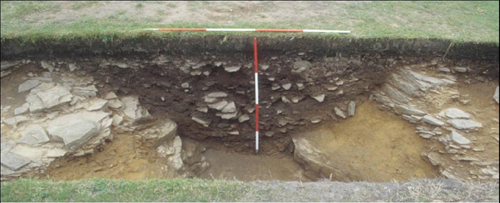
The Iron Age Period at Mellor
Around 2,500 - 2,000 years ago
Around 2,500 - 2,000 years ago

It is perhaps the most remarkable aspect of the site is that an Iron Age Hiil Settlement with a deep, inner defensive ditch, a shallower boundary ditch and several Roundhouses could be completely hidden under the flat suburban lawn.
 Unlike may comparative sites, there had been no indication above ground that these features had ever existed.
Unlike may comparative sites, there had been no indication above ground that these features had ever existed.
 Unlike may comparative sites, there had been no indication above ground that these features had ever existed.
Unlike may comparative sites, there had been no indication above ground that these features had ever existed.Life In Northern Britain during the Iron Age
We The inhabitants of Northern Britain during the Iron Age (later 8th Century BC to the time of the Roman invasion) were socially grouped as part of the Brigantes tribe, possibly from extended families.
They occupied loose territories, their settlements ranging from small homesteads to massive earthwork enclosures. The cool and wet climate of the North West seems to have have favoured animal husbandry rather than widespread agriculture and this together with the isolated and sometimes inhospitable terrain, may have divided the community into the small confederated groups which are assocated with the Brigantes.
What type of settlement was MellorInitially it was felt that Mellor was a Hillfort. However, as more excavation has been carried out each year and more of the area investigated, it seems more likely that it was a Hilltop Settlement.
A complex picture of occupation is emerging, with much earlier origins than the Iron Age and having undergone several phases of development,possibly similar to the site at Almondbury (20 miles to the North East)
The Prehistoric Ditches
Our understanding of the Prehistoric Ditches has deepened with each year of the excavation. The depth, indications of a palisade and size of the area the inner ditch enclosed suggest that it was at least partly defensive. Trench 25 also showed us that considerable landscaping have disguised the fact that it would have run right along the contour of the break of the slope, very visible and prominent to anyone approaching.
What do we know about the Roundhouses
There appears to have been at least four separate phases of roundhouse, with gully diameters of 10m - 12m and entrances positioned to the North West, although the site underwent numerous changes in usage, from domestic or industrial use, to partly enclosed and divided areas of stock control. It has proved quite difficult to unravel the complex pattern of postholes but the nature of the underlying bedrock and the wide availability of building stone, make it quite possible that timber uprights could have been supported on pads of stone or wood or that the walls of some structures might have been entirely constructed of stone but leaving no record as they were reused during a later period.
Iron Age activity and artefacts
Mellor has made an enormous contribution to our understanding of the Iron Age in the North West. It had previously been impossible to establish a sequence of pottery types as there had been so litlle material culture found. In 2001 however Mellor produced pottery from several Iron Age contexts, with a number of vessels being represented. Trench 15 produced an astounding 125 sherds of pottery belonging to the same Iron Age pot, which have now been conserved, reconstructed and typed as The Mellor Pot. Finds like the Briquetage Pottery fragments are also able to tell us that that the community had trading links with the salt production settlements within the Cheshire Plains possibly at Middlewich. Crucible fragments and Slag show continued use of bronze into the Iron Age and indicate an element of prestige at the Mellor Settlement. Analysis of slag from the site indicates that it is likely to be from Iron working and sheds new light on the utilisation of the site, as it is possible that the raw material was acquired through trade in the form of currency bars.
The Iron Age Landscape
Waterlogged areas in the lowest part of the ditch have yielded palaeo-environmental evidence revealing a landscape of mixed deciduous woodland, charred hazelnut seeds, cereal type pollen and associated weeds indicating a mixed farming economy.
The Reconstructed Roundhouse
In 2002, students from the Ridge Danyers Sixth Form College were involved in a European Community Culture Programme, the Mnesonyme Project, to reconstruct an Iron Age Roundhouse on the site, which remains in place, providing an evocative reminder of how the area might have looked during this period
Read about Mellor within the region in the 2000/2001 Archaeological Report
Read more about the Iron Age Period in Britain on the Channel 4 Time Team website
This page is currently under reconstruction
